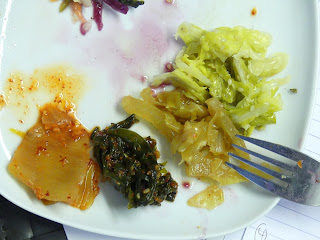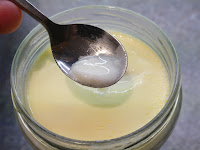I can't recall how I stumbled upon the Cold Smoking Cookery School which is based in Milton Keynes but I've had my eye on the Fermenting Food Workshop for around 18 months. Why so long? Well this course is on a Friday and if memory serves one of the bi-annual days was full and the other wasn't doable due to the date being unavailable at work to take off, this meant that I had to wait for the the next set of course dates to be released, book one of the days at work and hope that there was still space.
So I've been counting down the days from mid November to learn more as my foray into lacto-fermentation consisted of this single attempt. The workshop also caught my eye due to the fact that Kevan Palmer was leading it who I know from his bushcraft instructor background. I also did a Bushcraft UK post about the forthcoming day too.
This is Kevan (on the left) kicking off the first wild forage evening at The Foragers in St. Albans restaurant back in the day.


On the morning of the workshop I successfully took on and beat a misbehaving M1 to be the first there. I was greeted by the amiable business owner Turan, then met Kevan and had a quick catch up chat before grabbing a tea, taking a seat and getting myself ready. It was very obvious that there was a lot of containers on a table at the back as attendees slowly drifted in Kevan heated some milk for the yogurt session later.
Turan left us to it and then Kevan properly kicked off the session with a quick introduction and then onto the subject of lacto-fermentation. The cosy seated area was well served by the overhead screen and the information displayed was also given to each attendee as A4 sheets to take away too.
The website said that we would get the opportunity to taste stuff as we went along and I expected the odd the thing here and a singular version of something there but no, it soon became obvious that we would be sampling well in excess of my assumption.
The lacto-fermation tasting saw us given six different things to sample. The green one is foraged ramsons (allium usrinum) and clockwise thereafter a basic white cabbage sauerkraut made on the previous workshop, a four month old red cabbage sauerkraut, a Russian style made with white cabbage and carrot, Cortido which is a punchy recipe from San Salvador and a younger red cabbage sauerkraut a few weeks old.
We would be taking some stuff home and one of those things would be sauerkraut. We would all be offered the chance to prepare the stuff needed for our goodies. The first one was a white cabbage chopping session.
Kevan then weighed the cabbage and added the right quantity of salt (3%) to make the soon to be encouraged cabbage give up it's moisture.
Predictably the next audience participation was robustly scrunching the cabbage to get the moisture out.
Whilst this was happening Kevan made up some saline solution in case the cabbage needed a top up in the jars as any lacto-fermented product needs the air to be excluded.
Once the cabbage was ready it was forced down into the jars with a rolling pin. The amount of liquid that issues was demonstrated with a handful being squeezed and a decent trickle running out.
Once we had set aside the fledgling creations Kevan moved swiflty onto Kimchi which is essentially a sort of oriental sauerkraut. Again not just one version but four with the green one being made from Few Flowered Leeks which is actually what I used in my one and only lacto-fermentation foray.
I volunteered to take my turn to chop. I worked through Chinese Leaf and salad onions to the point where it needed decanting into a second bowl.
And I've included this Mooli shot simply because it almost deserves a caption competition.
So with my ingredients dispatched, and the spices having been prepped at the rear out came the trusty calculator again to work out the salt content.
These ingredients were then pounded as before to make them give up their moisture in the same way that the sauerkraut was.
Again, the agitated mixture was forced into jars. The outer cabbage and Chinese leaves weren't prepped but were saved to be used, quite ingeniously, at the end of the workshop.
At this stage I had to make a quick call and stepped out of the room and into the doorway. as I crossed the room threshold after the call the heady smell of our endeavours was really noticeable.
The water urn was always available but we took a quick 'official' tea break around midday before Kevan then took us into the world of yogurts. We tried standard, Greek style and mesophilic versions and learnt the difference between pro and pre-biotic versions..
We were taken through the making of these products with ideas on how to achieve the optimum low steady heat. I mentioned my dehydrator and as Kevan rightly pointed out the shelves are little shallow. A Heath Robinson set up will spring to mind I'm sure. Kevan then set a new batch off using the now cooled milk from earlier.
We briefly visited a whey and rye bread based beverage called Kvass (which beetroot soup was originally made from before we had some rather odd looking leathery discs flapped at us! This was taking into the world of SCOBY (symbiotic culture of bacteria and yeast) and Kombucha. This is basically a union of plain tea and the SCOBY disc and then a secondary fermentation can happen when flavouring is added.
The reason that we had the discs flapped at is was because we were taking them home as a concoction which wasn't mentioned in the website course notes.
Again we were given several versions to try (liquorice, coffee, chocolate and my personal favourite apple and woodruff (Galium odoratum)).
And last but not least we moved on both milk and water based Kefir. We had a reminder to open bottles and containers carefully as one bottle of milk kefir 'burped' over one attendee. He did find mirth in his slight misfortune. As well as the 'burpy' Strawberry version Kevan also had a vanilla, lemon zest, coffee and chocolate version on hand. Most attendees found the drinks quite sharp but as Kevan pointed out that's probably to do with our conditioned palettes.
With the strawberry milk keffir having been a bit frisky Kevan decided to open the lemon and lime, orange and cinnamon, raspberry and spiced chai water kefirs before handing them out.
Compare the above picture showing a section of a near empty table to the earlier picture I posted of a table groaning under jars and bottles, all made and brought in by Kevan for us to sample and we'd got through everything pictured. I'd got a small packed lunch in the car for the way home but it will come as no surprise that I hardly touched it.
The water kefir sampling neatly brought this four hour workshop to a conclusion. Turan had returned and was answering questions about other courses and Kevan had various workshop related paraphenalia for sale (I scored some water kefir granules) and I also relieved Turan of a bacon curing starter kit (results here). He also explained the cold smoking course that utilises one cardboard box which got me interested seeing as I was under the impression that you needed a burner, pipe and smoking chamber. Ironically Turan is a former firefighter so he has gone from considering smoke an enemy to considering it a friend.
Remember the peeled and unused outer leaves from the cabbages and Chinese leaf? We were reminded at the end to take a jar of the sauerkraut and kimchi (as well as our kamboucha), well the leaves were ripped and used as organic plugs to push down the contents.
In conclusion this workshop is greater than the sum of it's parts. As I've already alluded too we sampled well in excess of what I thought we would, this gives us a mental idea of what the stuff should taste like if we attempt it, we had easy to follow verbal and written instruction, the course is full but not pressured, we went home with three not two samples and of course, had the opportunity to by stuff to do at home and we all have an increased gut flora from all the homemade samples so if you are considering this bi-annual workshop book with confidence. Oh, and I would definitely advise bringing a camera, pen, paper and lots of notes/ coins if you attend.
Once home I set about putting some of the information into practice. After a visit to Manchester's Chinatown I've made some more Kimchi (which had Chinese Leaf, Bunchu, Green Mooli, Galangal and Gochujang paste in), used up the Bunchu to make a 'sauerkraut' with some chilli, as well as a foraged and a cauliflower and caper one, knocked out some SCOBY Sourdough, got the water kefir and kombucha on the go as well as making regular and strained yoghurt.
I thought I'd finish with some directions for finding the Coldsmoking HQ.
If you attend any workshop use the Google Map on their website contact tab because otherwise Google Maps via the web stops you a little short of the building and you are in an area called Parklands which according to the map is the name of the main street, side streets and the first roundabout!
And sure enough, this is the same turning to the right that my sat nav also plumped for. I bet the residents wished they had a pound for every set of corrective directions they've offered up.
With the unofficial finishing point to my right (just out of shot) continue ahead towards the church tower in the centre of the picture.
The road gently curves right and you'll see the foliage of the Parklands roundabout ahead.
As you go round the roundabout you'll see a thatched building to the right of some wrought iron gates. Head through these.
There is plenty of parking space to be had. This is the converted stable in the left hand corner that you need with the Grand Union canal to the left and Linford Manor across a sweeping lawn behind it. Of the little I've seen of Milton Keynes and surrounding areas I have to disagree with Mr Weller.








































No comments:
Post a Comment